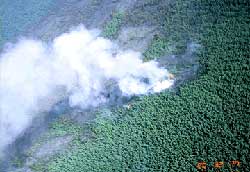Are Wildland Fires Fueling the Greenhouse?

Wildland fires are taking tons of carbon out of storage and feeding it into the atmosphere as carbon dioxide, a primary greenhouse gas. Drought makes things worse, stunting tree growth and turning forests into tinderboxes. And when human activity disturbs the environment, the ability of forests to store carbon is further diminished.
These are some of the preliminary findings from computer modeling studies of the Colorado wildfires of 2002 being presented in San Francisco, December 6–10, at the annual meeting of the American Geophysical Union (AGU). A team of researchers from Colorado State University (Fort Collins), the U.S. Geological Survey (Denver), and the National Center for Atmospheric Research (NCAR, Boulder) conducted the research.
“We’re using the western U.S. as a case study area where climate and land use are interacting in several interesting ways,” says NCAR senior scientist David Schimel, who’s been collaborating with Dennis Ojima (CSU) and Jason Neff (USGS) on the project. Western lands—especially the evergreen forests—represent roughly half of U.S. carbon storage. Changes in land use, fire suppression strategies, and climate all have potential to increase wildland fires.
The researchers developed a new computer model of a complex forest ecosystem to simulate the release of carbon during the 2002 fire season in Colorado. The findings estimate how much carbon would be stored in a normal year compared to a drought year, such as 2002. More carbon is freed from storage during droughts, not only because more tinder-dry vegetation burns, but because plants deprived of water grow more slowly, absorbing and storing less carbon in their tissues.
The conclusion from these early studies is that the fires have had a significant effect on the regional carbon balance, changing Colorado from a storage area to a source of atmospheric carbon. And, since carbon circulates globally, the Colorado fires even had a very small effect on the global carbon budget.
The team is also using computer models to compare different approaches to reducing wildland fire risk. To simulate regrowth of burned areas over the next 30 years, they use a scenario that includes the effects on vegetation growth rates of elevated carbon dioxide. The researchers then compare different fire management strategies. “We don’t know which method takes more carbon out of storage, mechanical thinning or prescribed burning, but that’s one of the questions we’re looking at,” Schimel says.
“Land disturbance is a fundamental factor shaping ecosystems,” Schimel says. Computer models have been used before to estimate how much carbon dioxide is circulating in the atmosphere, how much is stored as carbon in vegetation and soils, and how much is shifting between land storage and the atmosphere. However, “it’s much harder to take the system apart than early modeling efforts suggested,” says Schimel. For example, increasing road density in the West has been correlated with increasing wildfires. Both the presence of more people to ignite fires and the impact of roads on surface and groundwater are implicated. Clearcutting and road building channel away water formerly held in place by the living forest floor, causing a drop in the water table. The current project incorporates land use, drought, soil health, and other factors to better capture the complexity of ecosystem interactions at the local level.
Projections of climate change in the West include hotter temperatures and increased drought, a recipe for more forest fires. If further research supports the project’s early findings, “We’re either going to be spending a lot more money on fire suppression or we’re going to be seeing a lot more carbon released by wildfires,” Schimel says.
Writer: Zhenya Gallon
Media Contact
More Information:
http://www.ucar.edu/communications/newsreleases/2002/cocarbon.htmlAll latest news from the category: Ecology, The Environment and Conservation
This complex theme deals primarily with interactions between organisms and the environmental factors that impact them, but to a greater extent between individual inanimate environmental factors.
innovations-report offers informative reports and articles on topics such as climate protection, landscape conservation, ecological systems, wildlife and nature parks and ecosystem efficiency and balance.
Newest articles

Future AR/VR controllers could be the palm of your hand
Carnegie Mellon University’s EgoTouch creates simple interfaces for virtual and augmented reality. The new generation of augmented and virtual reality controllers may not just fit in the palm of your…

‘Game changer’ in lithium extraction
Rice researchers develop novel electrochemical reactor. A team of Rice University researchers led by Lisa Biswal and Haotian Wang has developed an innovative electrochemical reactor to extract lithium from natural…

The blue-green sustainable proteins of seaweed
… may soon be on your plate. The protein in sea lettuce, a type of seaweed, is a promising complement to both meat and other current alternative protein sources. Seaweed…



